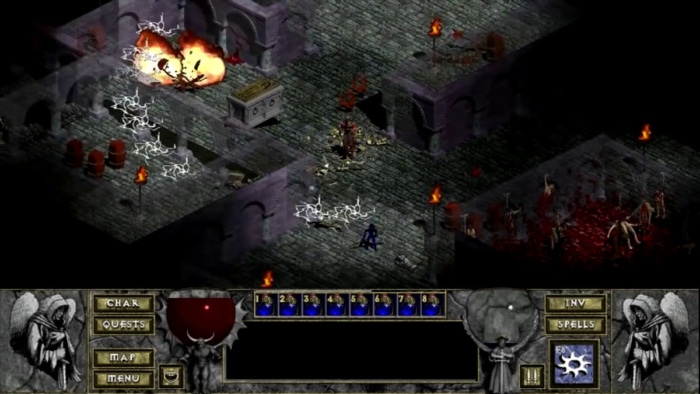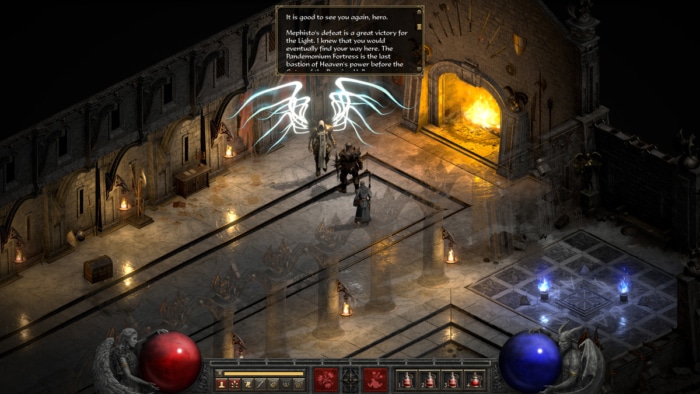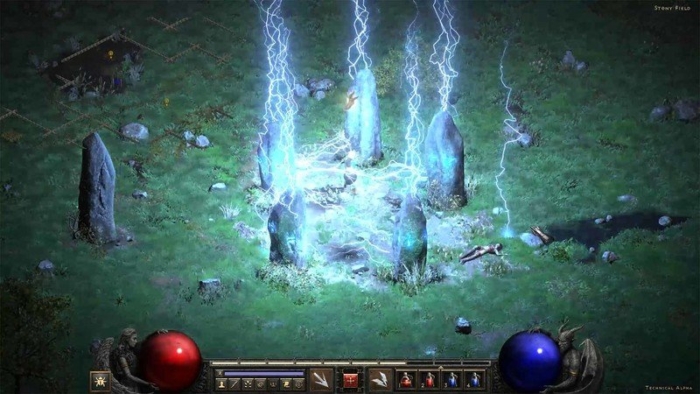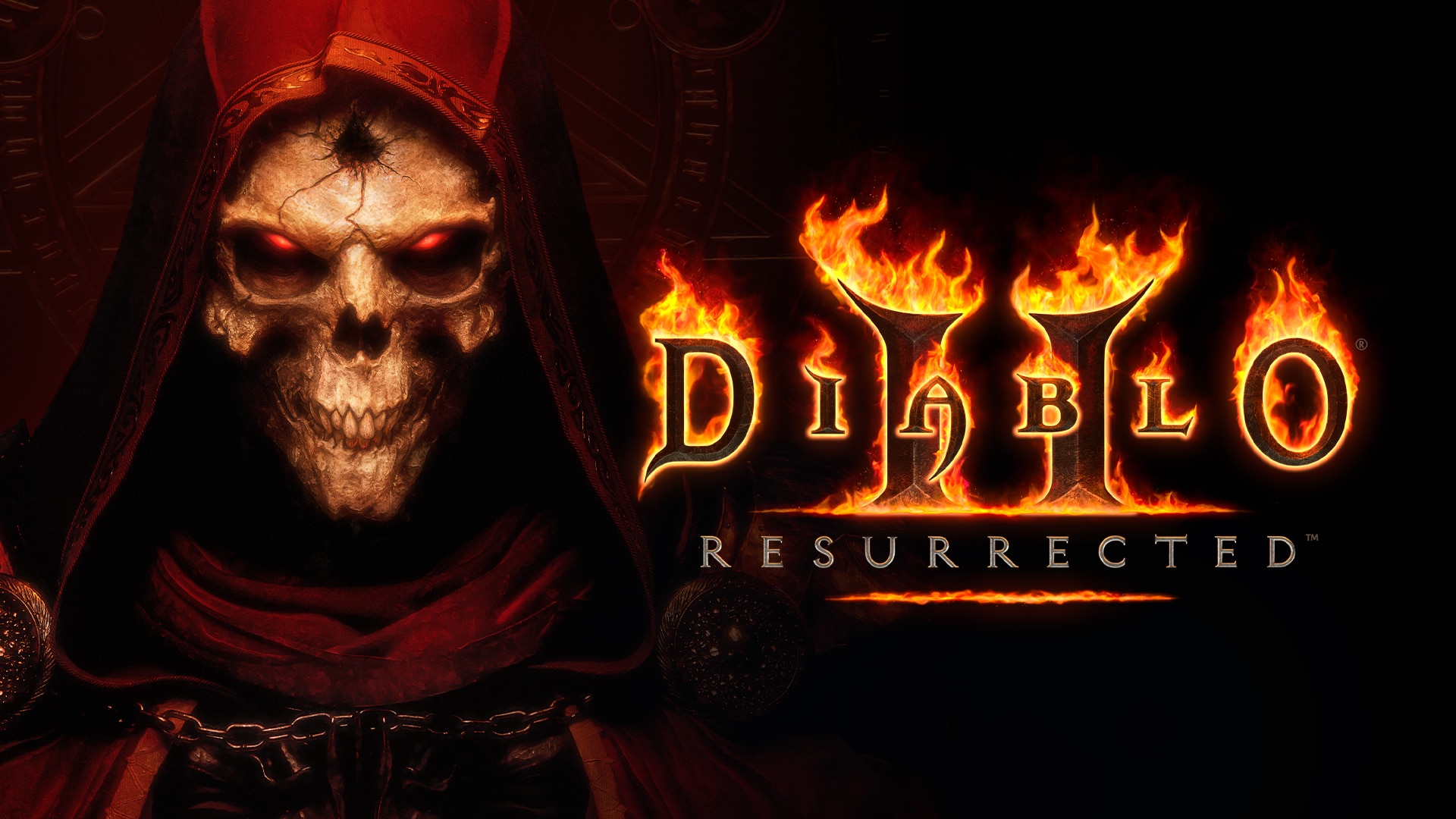The Complete History of Role-Playing Games (RPGs): Part 10 – Fighting Demons from the Top Down in Diablo
Role-playing games, or RPGs, form one of the most lucrative genres of computer games in the world today, demanding tens of hours of dedicated play from gamers and rewarding them with rich storylines, memorable characters and an often emotional escape into other worlds.
How did RPGs come to be? What are their origins and how did this once-minor pastime of interactive storytelling become an industry behemoth? Here at Ultimate Gaming Paradise, we have some of the answers, brought to you in this growing series of articles.
It’s time to face the demon.
Episode Ten: Fighting Demons from the Top Down
In part three of this series, we looked at the subgenre of RPGs—Roguelikes. With their procedurally generated dungeons, use of basic text to represent the creatures and environment, and compelling repeat gameplay, Roguelikes took the crown for RPGs in the early 1980s.
But what happened to them after that?
Perhaps the most influential game to spin-off Rogue in the 80s, Gauntlet brought real graphics and multiplayer action to the table and, for a long time, remained the only game of its type able to touch the mainstream. With the majority of role-playing games remaining steadfastly turn-based rather than action, Gauntlet was an outlier, regularly dismissed as not a role-playing game at all, but just an action game with fantasy characters.
Not an unfair assessment, really.
There was a selection of RPGs that did push away from turn-based combat, including some famous titles like Secret of Mana and Dungeon Master, but they focussed on the stat-based RPG elements with the real-time aspect a secondary feature and could hardly be called ‘action’ titles. Only The Legend of Zelda stood out as a successful action RPG game, and that relied on a predetermined game world so didn’t quite do the job of being an upgrade to Roguelikes.
Staggeringly, it wasn’t until the second half of the 1990s before Roguelikes found a champion.
Isometric Dugeoneering
The game was Diablo. Released in 1997, DIablo was a game that completely revitalised and re-invented the entire Roguelike experience for millions. It had absolutely everything that people loved about Roguelikes but brought them up to date with an impressive array of additional extras. Here we had a game that provided a story-based quest; a strong sense of improvement through experience; a staggering selection of weapons, armour, and magic; and graphics that made the dark and twisted scenario come to life (or undeath) on monitors everywhere.

Diablo stole your soul. Hours would pass as you continued to delve down through the dungeons, building up your character through the acquisition of greater and greater wealth and experience points, determined and desperate to kill the demon butcher who dwelt in the lower recesses.
While Playstation users were fawning over the majesty of Final Fantasy VII, PC gamers countered at almost exactly the same time with Diablo. Truly, 1997 was a seminal year for computer RPGs.
Diablo brought a new perspective to the role-playing game genre. It was dark, filled with skeletons and zombies, and utilising an adjustable gamma setting to give it real ‘close your curtains and turn out the lights’ depth. And, it was an action title in third person isometric ‘2.5D’.
When Turn-Based Isn’t Turn-Based
Play Diablo today and you can see that it’s not quite as real-time as people think. The game was originally developed as a turn-based Roguelike and altered at a late stage to play in real-time thanks to the insistence of the publisher, Blizzard. Developer David Brevik thought that the change would take many hours of coding time but pleasingly completed the adaption in a weekend and, though that is no doubt something to applaud, it shows.
Diablo works by having an effective ticking clock. If you do nothing, turns for the monsters get played out in the background and they will make their moves (including coming to kill you) while you stand there motionless. By some definitions, it’s a real-time action game, but really it’s just a never-ending sequence of turns ticked over whether you interact or not.
Nonetheless, it plays excellently and when the combat is intense, it’s hard to tell the difference.
Bringing the Roguelike Back into the Spotlight
The spectacular success of Diablo (it sold very quickly in the millions), brought the subgenre of Roguelikes squarely back into gamers’ interest. No longer restricted to ASCII attempts at graphics, Diablo would stand as overlord, spawning clones wherever it went.
One of the first of these was actually Diablo itself. Remember those FFVII-loving Playstation gamers? They were treated to a version of Diablo in 1998 which utilised a completely different control system—the PC version was a point-and-click game, where you simply clicked where you wanted your character to walk and off they went. Spells were targeted by right-clicking on the bad guy as they approached, and so on. With no mouse, the Playstation version needed redeveloping for the controller and by doing so became something even more.
That said, sadly the Playstation version is inferior in almost all other ways (graphics, sound, etc.) to the PC game.
The clones are many, and plenty of those try their hardest to improve in some way or another, whether through giving more camera controls, a different magic system, or upgraded graphics, but for many years very few could truly challenge Diablo itself. Games like Ancient Evil (1998), DarkStone (1999), and Revenant (1999) all tried their best to kill the demon. All failed.
Diablo II
In 2000, it was Blizzard and the original developers of Diablo who finally made something better. If the original had opened a door, Diablo II ripped it off its hinges and charged on through. This was a game that truly breached the divide between role-playing gamers and those just looking for a fun action game. It was engrossing, addictive, and came with a selection of weapons and equipment that bordered on the ridiculous.
Diablo II has often been cited as one of the best games of all time, and for good reason. It really is that good.
The Importance of Multiplayer
Diablo had it, but Diablo II owned it. Multiplayer adventuring across local area networks, or even the internet, was a way of making the basic dungeon crawling a whole load more exciting. This was the era of the internet cafe, a place where many people would come to check emails or see what was going on on the new-fangled ‘world wide web’. They’d stay because they were playing Diablo II. More than one internet cafe made a few alterations to their business plan, adding local area gaming to their suite of product offerings in order to entice people to use the facilities, and Diablo II was one of the games at the heart of that—certainly, the first to have ‘role-playing game’ in its description.
It wasn’t just multiplayer that Diablo and its sequel were to give the RPG world, however. The list of clever innovations that Diablo and Diablo II pioneered is impressive, from the whole loot system with various levels of rarity, through to the clever way the inventory dealt with size and encumbrance. It had pre-designed characters to allow you to just jump in and play, player-vs-player combat, innovative character classes, and the ability for gamers to create their own modifications, or ‘mods’.

Diablo II had learned from games in other genres too, and there are influences from DooM to the collectable card game Magic: the Gathering to be seen throughout.
Its legacy is impressive.
Returning to the Forgotten Realms
Remember Dungeons and Dragons? The granddaddy of all of this was still a huge brand with growing success in the computer game arena. The Baldur’s Gate series, a more traditional RPG set in the setting of Forgotten Realms had a huge following. Baldur’s Gate II, released in 2000, is another impressive RPG, combining real-time action with a ‘pause’ system that allows you to slam the spacebar down when you need to think and reassess your situation. It’s a fantastic mix between action and a more traditional RPG of the time and gathered fans not just for its AD&D tie-in, but also as a strong RPG gaming experience.
Despite the similar viewing angle, however, the main Baldur’s Gate series wasn’t stepping on Diablo’s toes. This was to change with the Playstation 2 title Baldur’s Gate: Dark Alliance.
Dark Alliance was a fantastic take on the Roguelike-now-Diablolike genre. With console gaming at its core, it provided a co-operative two-player adventure that was bright and entertaining. With the newly released Advanced Dungeons and Dragons: 3rd Edition ruleset at its core, Dark Alliance succeeded in playing like an action-centric computer game equivalent to the tabletop game. Thanks to the main Baldur’s Gate series and this spin-off title, players were finally seeing some really tangible likeness between the dreams of the late 1970s and the gaming environment of the 21st Century. It had taken more than two decades, but computer role-playing games were finally doing the thing they had set out to do.
Finding Space for Top Down in Modern Gaming
As we will see in later episodes of this article series, RPGs of the 2000s and 2010s develop in different directions, with both first- and third-person perspectives overtaking the isometric 2.5D view that Diablo popularised. That said, top-down dungeon-crawling has never died and plenty of series remain popular with players today.
Diablo itself spawned its third version in 2012. Another extreme hit, Diablo III is a superb game that has many aspects of its predecessors. Purists, however, feel it is lacking some of the heart that made Diablo II such a must-have title, and though it sold in the millions, Diablo III never made the impact the series deserved. At the time of writing, Diablo IV is in development.
Baldur’s Gate: Dark Alliance went on to have its own sequel, one that is similarly enjoyable. After that 2004 game, however, the series seemed to fall by the wayside. It has seen a resurrection in Dungeons and Dragons: Dark Alliance from 2021, though this latest game has dropped the 2.5D look for a more current third-person perspective.
Dungeon Siege saw its apex with its third iteration in 2011. Though not breaking any new ground, Dungeon Siege III is a solid interpretation of the genre and deserves more attention than it received.
Titan Quest, from 2006, was another excellent title in the Diablo vein. With impressive graphics for the time, it was beloved by many fans. Like many other similar titles, more recent games by the team behind the game have veered towards the third-person perspective, leaving Titan Quest and its expansions without a modern generation update.
None, however, have ever managed to quite recapture the magic of Diablo II.
Resurrecting the Past
If Diablo II remains the defining moment for the genre, why not simply remake it for a modern gaming audience?
Which is exactly what Blizzard has done.
Available for all modern platforms in 2021, Diablo II: Resurrected shows exactly what this spin-off genre was all about. Updated graphics and other similar tweaks exist, but the game is still everything it was twenty years ago. Sometimes there’s simply no improving on perfection.

Leaving a Legacy
As computer hardware improved, the reasons for the isometric 2.5D viewpoint have long since gone. The reason Diablo, Baldur’s Gate: Dark Alliance, Dungeon Siege and all the others looked the way they did was purely because that’s what the hardware of the time could handle.
Their legacy is in the third-person RPG arena, a more modern graphical take on these core origins. Most action RPGs of today owe their roots to the cusp of the millennium, to Diablo and its stablemates and, by extension, the very early days of Rogue.
Coming Next…
It’s time everyone joined in. One of the biggest expansions of the RPG genre was when the internet connected everyone and enabled the massively multiplayer online role-playing game.
Come and join in—there’s lots to see…

